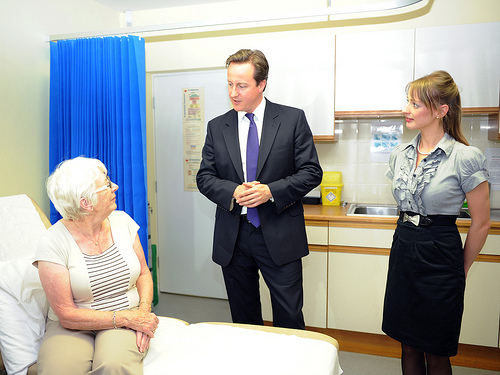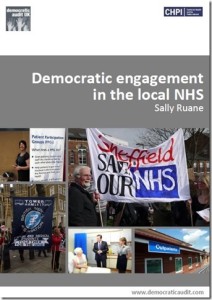Citizens’ ability to influence NHS services is undermined by the complexity and ceaseless reform of systems for patient and public representation
Unlike many other public services, the NHS is not subject to local democratic control. In this post – an extract from a new Democratic Audit ebook – Sally Ruane explores the recent history of patient and public involvement in the NHS, including the impact of the coalition government’s reforms.

How have the coalition’s reforms affected local accountability in the health service? Credit: Number 10, CC BY-NC-ND 2.0
Any examination of democracy in the NHS is troubled by confusion and complexity. The ‘NHS’ itself is a term which needs unpacking and arguably it would be more accurate to say ‘health system’. Significant elements of the English health system now lie outside the NHS proper.
Public health has been transferred to local authorities. Local authorities also host both the Health and Wellbeing Boards, which oversee health strategy and foster greater integration of health and social care and more joined-up commissioning; and health scrutiny committees, which review and scrutinise any matter relating to the planning, provision and operation of health services in the local authority’s area.
Additionally, the 2012 Health and Social Care Act builds on New Labour policies to extend market principles and diversity of provider so an increasing number of health service providers will be from the ‘independent’ sector and by 2016 organisations supporting the commissioning function of clinical commissioning groups (CCGs) may also fall outside the public sector.
A source of confusion lies in the multiple forms of participation and involvement which proliferated, particularly under New Labour’s public and patient involvement (PPI) agenda, but which did not necessarily contribute to democratic accountability or democratic determination per se. Both democratic determination and democratic accountability matter. By democratic determination, I mean the ability as citizens, rather than as consumers, to shape the overall direction of policy and the principles upon which that policy rests and to shape in broad terms the allocation of resources. The ultimate test here is whether it is possible that citizens can require commissioners and senior managers to change course when they would otherwise not have done so. Democratic accountability refers to the requirement to give an account for one’s actions before the public and the public’s elected representatives and to be held responsible for those actions, suffering punishment if necessary. My focus is on influence exercised locally rather than nationally and on citizen rather than consumer engagement. This is a conceptually fraught area but where consumers (service users and carers) are concerned more with individual experiences of received services, citizens have a wider remit in considering not only the consequences for themselves but also the consequences for different groups in society and for different aspects of our socio-economic and politico-cultural lives.
Changing arrangements for local ‘voice’
There is nothing new about a democratic deficit in the health service. The NHS of 1948 was notably paternalistic and medically dominated with a system of accountability which went upwards to ministers but not outwards to patients, public and local community. This was addressed to some extent through the creation of Community Health Councils (CHCs) in the 1970s. These were far from perfect: they were under-resourced relative to the scope of their activities, operated under a complex accountability structure, and had no right to be consulted on matters of service design or strategic planning. However, some of them proved very effective in handling complaints and in focusing public opposition to unpopular local policy proposals and their abolition under New Labour was controversial.
Their combination of championing individual patients, ascertaining local views and rallying local citizens to challenge unpopular policies has not been re-created in any single body and the replacement arrangements comprise an array of patient and public involvement mechanisms. The immediate successors to CHCs were themselves abolished in 2008. These institutions were subject to criticism for fragmentation, incoherence, difficulties in recruiting members, lack of independence and limited powers.
Overall, the repeated disruption of systems for patient and public representation undermined the ability of individuals and institutions to build up knowledge, skills and experience in effective intervention. That this occurred during a period in which the health service was restructured along market lines and service reconfiguration was rarely out of the headlines reinforced the impression among critics that governments welcomed consumerist models of involvement but sought to make it impossible for people to mount an effective challenge to policy as citizens.
So, although a plethora of modes of involvement was developed under New Labour’s PPI agenda, most of these did not amount to democracy and indeed may even have undermined it by conferring a spurious legitimacy upon policies determined by local health decision-makers. The very volume of channels for participation may have distracted attention away from the scantiness of real power. Under the coalition government, the flagship engagement policy is Healthwatch, but this, too, does not look as if it will offer a strong means for democratic engagement. Each local authority is required to contract an organisation to provide a local Healthwatch, established as a social enterprise. Local Healthwatch is charged with providing feedback to providers about service user experiences in health and social care; representing the views of patients and public to the Health and Wellbeing Board and ensuring they are taken into consideration in needs assessment; and reporting concerns about quality to Healthwatch England (a national body). Healthwatch has a right to refer matters of concern to the local overview and scrutiny committee. Early criticisms of Healthwatch have emphasised its under-resourcing, role confusion and role dilution, the steep challenges it faces in becoming a representative body and its possible incorporation or part incorporation through membership of the Health and Wellbeing Board (along with being contracted by the local authority).
–
This post is an extract from Democratic Audit’s new ebook, Democratic engagement in the local NHS, which includes further analysis from Dr Ruane on the barriers to engagement and recommendations for enhancing local accountability in the health service.
Note: this post represents the views of the author and does not necessarily give the position of Democratic Audit or the LSE. Please read our comments policy before commenting. Shortlink for this post: buff.ly/1eEmJHE
–
 Dr Sally Ruane is the Deputy Director of the Health Policy Research Unit at De Montfort University, Leicester and a member of the Centre for Health and the Public Interest’s executive management team. She has published in books, academic journals and magazines in the UK and Spain and has a particular interest in the private finance initiative, service configuration and political aspects of the policy process.
Dr Sally Ruane is the Deputy Director of the Health Policy Research Unit at De Montfort University, Leicester and a member of the Centre for Health and the Public Interest’s executive management team. She has published in books, academic journals and magazines in the UK and Spain and has a particular interest in the private finance initiative, service configuration and political aspects of the policy process.






 Democratic Audit's core funding is provided by the Joseph Rowntree Charitable Trust. Additional funding is provided by the London School of Economics.
Democratic Audit's core funding is provided by the Joseph Rowntree Charitable Trust. Additional funding is provided by the London School of Economics.
RT @Luke_Ashby: Informative article on #NHS #democracy and patient represntation @ERSvotes @MESsocial @Nick_MES https://t.co/AE1PHyd8vH
Citizens’ ability to influence NHS undermined by complexity & ceaseless reform on @DemocraticAudit https://t.co/aWcctleBHi #nhscitizen
Interesting ebook @democraticaudit on patient and public involvement in NHS https://t.co/6hZmZwnXqC
Interesting article.. Possibly too thought provoking judging by the number of questions below ( which I apologise for)
From your research I wonder how well you think elected county health boards would work, with a mandate to oversee and maintain ( or improve ) standards within their local area?
Also how damaging would you say ‘constant reform’ has been, both from a citizen’s standpoint and that of a medical professional within the NHS? Is it partly this which has resulted in the administrative bloat of the NHS?
Would it be possible to give an opinion on the likely benefits of relative stability and democratic accountability of some form?
RT @PJDunleavy: Citizens can’t influence NHS services because of the complexity & constant changes of patient & publ… https://t.co/N4pkAwqoru
Good to see positive findings about health #scrutiny here https://t.co/t2nWtM2KU1
https://t.co/wOjq1tfTIL short, clear analysis of fragmentation and accountability problems in NHS.
Citizens’ ability to influence NHS services is undermined by the complexity and ceaseless reform of systems for pat.… https://t.co/DfhzGPCB9N
The short and convoluted history of patient & public involvement in the #NHS https://t.co/nMVO8Ck2yf
“@PJDunleavy: What stops people influencing local NHS? Sally Ruane says endless reform & complexity: https://t.co/MW5O9541Jp”” #nhscitizen
What stops people influencing their local NHS? Sally Ruane of @CHPIthinktank says endless reform and complexity: https://t.co/CXx2cL77p6
“@democraticaudit: What stops people influencing their local NHS? Sally Ruane says endless reform and complexity: https://t.co/9X11MRI4yB”
Citizens can’t influence NHS services because of the complexity & constant changes of patient & public representation https://t.co/pLxvBDeiRd
Insightful analysis of democracy in the NHS from Sally Ruane on Democratic Audit today – new ebook https://t.co/BgeAQt28eZ
Complexity and ceaseless reform of NHS structures undermines local accountability https://t.co/bWirXsB2Za